
Contact

Home
Loch Ness Monster
SCOTTISH LAKE "MYSTERY"
"DAILY NEWS" DISCOVERS A MONSTER
THE UNKNOWN ANIMAL OF LOCH NESS-SOME SUGGESTED IDENTIFICATIONS
By: Rip Van Winkle
Sunday Times (Perth, WA)
Date: October 22, 1933
Page Number: 3 S
The following wondrous message appeared in the "Daily News" the other day:
"SCOTTISH LAKE MYSTERY
"Unknown Animal Inhabits Loch Ness
"Eyes Like Lamps
"(Special to 'The Daily News')
"LONDON, October 18.
"The 'Daily Mail,' the 'Scotsman' and other newspapers, print double column accounts of a mysterious monster reputed to dwell in Loch Ness.
"Scores of watchers in the past few weeks declare that they have seen a beast swimming with terrific speed. It has a black back with a pronounced hump, a neck seven feet long and eyes like motor car lamps. Its total length is 30 feet.
"Apparently it does not desire to molest humanity. It seems timid.
"Some people consider it is a prehistoric animal released from subterranean caverns by blasting operations; others say it has strayed into the lake from the North Sea.
"Loch Ness has a sinister reputation. lt never gives up its dead. Though the greatest sounded depth is 754 feet, parts have never been plumbed. Divers have reported that gloomy caverns stretch into infinity like great cathedrals.
"Residents want the Scottish Fishery Board to Investigate."
The "Dally News" cable service of October 18 must have delayed mentioning this monster of Loch Ness for some weeks because the scare was reported in English newspapers weeks and weeks earlier, and the "mysterious monster" was photographed by the English Press, and was discovered to be a log with a branch on it.
Probably the "Daily News" special correspondent who flashed this absurd stuff across the cables on October 18 got his first inkling of it from a Scotsman returning from a Hallow'en celebration, or, maybe, a Burns' Nicht.
And although we are told that this mammalian denizen of the deeps of Loch Ness "does not desire to molest humanity and seems timid," the chances are that it chased the Scotsman home to his front gate, only to be scared away by the bagpipes and the perfume of Haggis from the palpitating breath of the Scot.
Scottish lakes, if this is a "Scottish Lake Mystery," are not of the type we were taught to define in old-time school geography--a sheet of water entirely surrounded by land. Loch Ness is a sheet of water entirely surrounded by "Daily News" correspondents. Some say it "has strayed into the lake from the North Sea." This seems to suggest that the "prehistoric animal" is the Irish Banshee, which has taken refuge In Loch Ness for the sake of peace and quietness.
On referring the matter to a well known Perth zoologist, who has had a wide experience of such things, and
was once chased into his front gate by the calf of a tram car, be ventures the opinion that probably the extraordinary visitant to Loch Ness is the Bunyip, which was originally discovered in Victoria, but has not been heard bellowing for some years past. If it isn't the Bunyip it may be a young Bunyip, some of the spawn of the Bunyip having been picked up in a Gippsland swamp by a Scotsman who thought it was porridge.
On the other, hand the Tantanoola Tiger has been missing from its haunts for a very long time, and as many Australians declared that the Tantanoola Tiger had wings and webbed feet it is quite probable that it flew to Loch Ness for a freer life, and is swimming in the lake, having been starved from the subterranean depths, and is now walting for a local resi- dent to give it some food--in which case it will be dead before very long.

Hallow'en
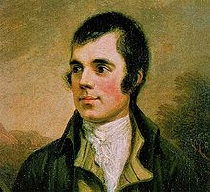
Burns Nicht
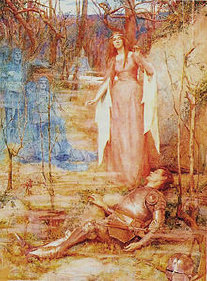
Banshee
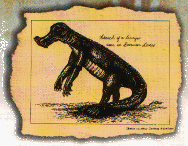
Bunyip
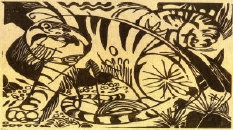
Tantanoola Tiger
A shorter version of this article (which ended in the line: "Residents want the Scottish Fishery Board to Investigate") appeared in newspapers around the country on the 18th and 19th of October, 1933. These seem to have been the first appearance of the Loch Ness Monster in the Australian and international media.
The frenzy of activity around the loch seemed to have been sparked by this account:
The most famous terrestrial sighting is that claimed by Mr and Mrs F. T. G. Spicer in July 1933. While driving along the road between
Dores and Foyes on the south shore, they saw a horizontal, trunk-like object emerge from the bushes at the side of the road: it moved
in a jerky, undulating fashion and was described as elephant grey in colour [one version of their sketch is shown here]. A curious
detail is that something seemed to be protruding from the animalís shoulder region, as if it was carrying something. The Spicerís
account became remarkably embellished over time. The object started off as being 6-8 ft in length, but later grew to 25 and even 30
ft.
THE "MONSTER" OF THE SCOTTISH LAKES
Sunday Times (Perth, WA)
Date: October 29, 1933
Page Number: 8 S
The mystery of the "unknown animal," given such prominence in the "Daily News" recently, was
solved when a curiously shaped tree trunk was washed up on the south side of Loch Ness.
THE MONSTER.
Sunday Times (Perth, WA)
Date: October 22, 1933
Page Number: 4 S
Scottish cable: "Scores of watchers in the past few weeks declare that they have seen a beast swimming with terrific speed in Loch Ness. It has a black back, with a pronounced hump, a neck seven feet long, and eyes like motor car lamps. Its total length is 30 feet."
In deep Loch Ness
I kinder guess
To bathe is rather risky;
But while of monsters black they write
With eyes like car lamps, big and bright
Did anyone say whisky?
THAT MONSTER
Loch Ness Mystery Deepens
Sunday Times (Perth, WA)
Date: December 3, 1933
Page Number: 22 S
(Special by Our Fishing Expert.)
Rip Van Winkle writes:
"It is more than five months," says a Scottish contemporary, "since people resident on Loch Ness-side reported the appearance of a huge fish, possessing at least two humps, measuring 30 odd feet, and having an extraordinary turn of speed, so much so that a public omnibus, driven by Mr. A. J. Gray who lives at Foyers, a village by the shores of the loch says he was unable to overtake it."
It will be remembered that this was the "Monster," about which the Perth (W.A.) "Dilly Noose" became excited about six weeks ago--the cabled account of which came from its "special correspondent" by the round the world route, via Mars and Jupiter, and took four months to arrive.
Far be it from me to argue with Scottish people about what they see on the shores of Loch Ness, however. Stranger things have been seen at Monger's Lake and Hyde Park on moonlight nights, and by the banks of the Avon River, where the Northam "Monster" bellowed one evening and drove children screaming to their beds, whilst the faces of brave men blanched, and even the hen that came into town on Frank McKinnels motor car cackled in alarm, it may be remembered that the Northam "Monster" was never identified, and both Bennie Burch and Pat Coffey were able to provide alibis.
But there is something more tangible about this Loch Ness business: Here is a bus driver who couldn't catch up with it, so let us apply the acid test of reason to the phenomenon. Firstly, let us consider the speed of bus. Does a bus ever overtake anything? What is the speed of a bus--its cruising speed? An examination of police court evidence concerning accidents reveals that the speed of buses, motor cars and , motor bikes, is from 16 to 20 miles, per hour--on the right side of the road. No motor vehicle, in police court evidence (which is always sworn), has ever exceeded 20 miles per hour. Take the speed of the old Coburg, Melbourne, horse trams. A man once lay on the tram line to commlt suicide at Coburg--and he died of starvation waiting for the tram to run over him.
But Mr. Gray, the Loch Ness bus driver, believes that he saw the "Monster." He then went to "an Inverness taxi-dermist to make special tackle with the object of catching the 'Beast.' It consisted of 90 yards of stout wire, attached with strong hooks baited with dog-fish. The monster has, however, refused to bite." Why a bus driver should go to a taxi-dermist to get his fishing lines, only a Scotsman can know. He is not a taxi driver, but a bus driver--and he goes to a taxi-dermist.
However, let us on with the "Monster": "It was recently seen; so it is said, crossing the public road, dragon- like, with what appeared to be a lamb in its mouth. This report has created widespread alarm along the valley of the Ness." There is room for much speculation in this report. How many people at Loch Ness have seen things crossing the public road "dragon-like?" The writer has questioned several Scotsmen in Perth who know
Loch Ness. From what he could understand--and its a great pity that Scotsmen don't speak English--not one of them ever saw anything crossing a road "dragon-like." They have, without exception, eaten haggis at least once, prior to coming so far away from the scene of the feast to forget it, and have never suffered any ill-effects. They have all attended a Hallowe'en--and never met a dragon on the way home, prior to, meeting their wives. This is not surprising, perhaps, when one considers what sort of beings Scotsmen eating haggis and coming home from a Hallowe'en would be. No discreet dragon would think of taking the risk of smelling the breath of a Scotsman in these circumstances. Dragons are a fast, disappearing genus--and the odds, are that they disappear as fast as possible on the banks of Loch Ness when a Scot is coming home from the Caledonian Society or the local bus is heard approaching, or Sandy is sounding the Pibroch.
Let us once again return to the newspaper reports. Here is another paper, the "Northern Chronicle," of October 11 last, giving a column to the "Monster." It finds that there are also "Monsters", in Lochs and Quoich, the latter being at the head of Glengarry, where the caps come from. This obviates jealousy between the lochs. The Loch Quoich "Monster'' ought to be able to cap them all. Two gamekeepers saw the "Monster," but they refrained from telling their experience, for the simple reason that nobody would have believed them." The "Northern Chronicle" knows what sort of people Loch Quoich gamekeepers are, evidently. I don't. It admits that nobody would have believed them, but is credulous enough to accept their statements, for publication, with the qualification that "both men are considered to be sound and solid people." "Solid" seems to be a good word, to this writer.
Twenty years ago, some children went bird-nesting, amongst them being Mr. Wm. Macgruer, now 20 years
older, but no wiser:
"it had a long neck, a small head, a humped-up back, and fairly long legs. It was, however, considerably smaller than a camel, but its skin or hide was almost the same color--pale yellow."
Pale yellow! Now here is a man who tries to describe what the "Monster" looked like 20 years ago. He says it was like a camel--"pale yellow." He doesn't even know what a camel looks like. Whisky is pale yellow, so are canaries. Mr. Macgruer was bird-nesting. It was probably a canary he saw.
The "Monster" might have been a camel--but it wasn't a Scotsman. A camel can go without a drink for seven days--but a Scotsman can't.

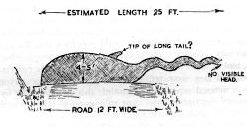
Above: A sketch as described by Mr. and Mrs. Spicer.
Right: How it may have appeared from 200 yards away.
Below: The "mythconception".


Another reference from 1935: "Frank McKinnel also came along on Wednesday, but didn't have a fowl roosting on his motor car hood this time."
What's the deal?
Bennie Birch and Pat Coffey seem to be well-known local "characters" but would appreciate more information...
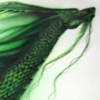
Pibroch, piobaireachd or ceÚl můr is an art music genre associated primarily with the Scottish Highlands that is characterised by extended compositions with a melodic theme and elaborate formal variations.

1933
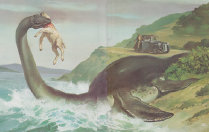
Contents













